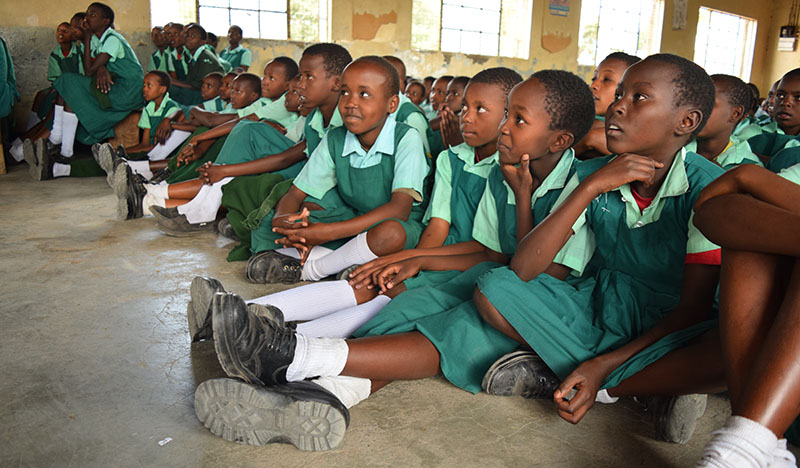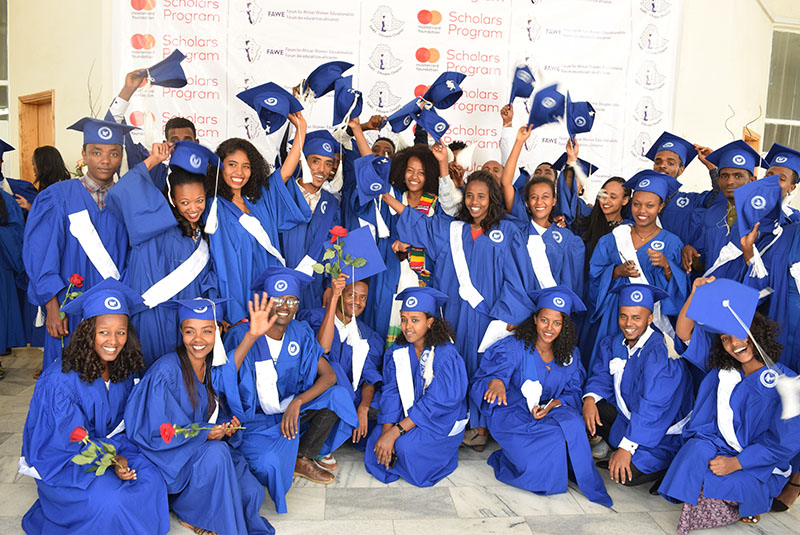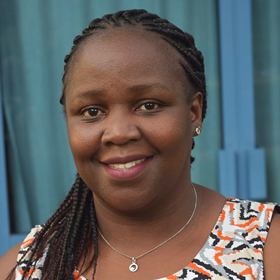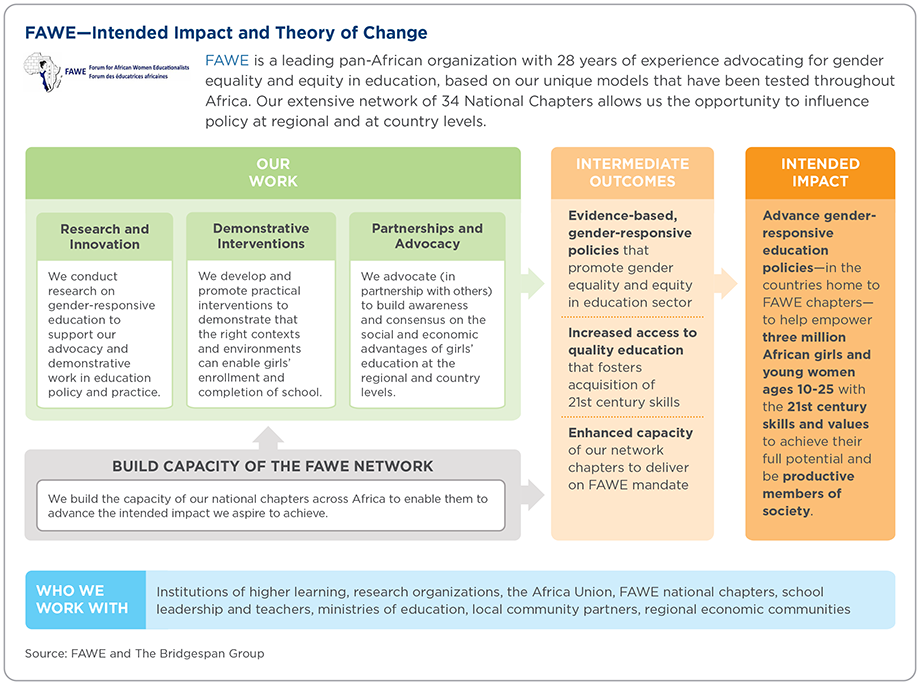Organizations that focus on advocacy, policy, and research work by influencing other actors to change their policies or actions in order to benefit a specific population or cause.
The WHO of their intended impact might focus on the audiences and systems they need to influence, their population of focus, or some combination of both. It should be closely tied to an end goal (the WHAT) that reflects a point of accountability for the organization, one that can be measured. Moreover, since the end goal may take a long time to achieve, many advocacy- and research-focused organizations find it helpful in their intended impact to align on a specific set of interim goals achievable within a reasonable timeframe (one to five years)—for example, the adoption of specific policies in addition to the ultimate goals those policies are intended to achieve.
For more on intended impact and theory of change see our collection of case studies, articles, and tools on the topic.
When it comes to theory of change, such organizations may find it difficult to predict the specific activities they will need to undertake to achieve their intended impact. Their work is often influenced by factors outside of their control—for example, a new law or a window of opportunity offered by a policymaker. Thus, it is important to balance the need to stay focused on strategy with flexibility in implementation. Rather than devoting extensive time to predicting an exact path, organizations often find it helpful to focus on clarifying the skills, capabilities, or tactics the organization is best positioned to use (e.g., litigation, grassroots organizing, media relations, storytelling) while accounting for the ecosystem of other actors working to achieve similar goals.

The Forum for African Women Educationalists
Overview
Mission: To promote gender equity and equality in education in Africa by fostering positive policies, practices, and attitudes towards girls’ education.
Intended Impact: Advance gender-responsive education policies—in the countries home to FAWE chapters—to help empower three million African girls and young women ages 10-25 with the 21st century skills and values to achieve their full potential and be productive members of society.
Theory of Change: FAWE uses a four-pronged holistic approach to achieve gender equity in education across Africa:
- We conduct research on gender-responsive education to support our advocacy and demonstrative work in education policy and practice.
- We develop and promote practical interventions to demonstrate that the right contexts and environments can enable girls’ enrollment and completion of school.
- We advocate (in partnership with others) to build awareness and consensus on the social and economic advantages of girls’ education at the regional and country levels.
- We build the capacity of our national chapters across Africa to enable them to advance the intended impact we aspire to achieve.
Founding year: 1992
Revenue: $7.5 million (2019) fiscal year
Field: Girls’ and women’s education
Geography/footprint: Sub-Saharan Africa
Website: http://fawe.org/
The Forum for African Women Educationalists (FAWE) is a membership-based pan-African organization that promotes girls’ and women’s education through its network of 34 national chapters. Founded by five women ministers of education, advocacy has been a strong focus for decades, to influence both policymaking and on-the-ground action that aim to reduce gender disparities in education. In 2019, FAWE welcomed several new members to its leadership team, including a new executive director, prompting a fresh look at the organization’s intended impact and theory of change. (See a visual representation of FAWE’s intended impact and theory of change below.)

FAWE’s Deputy Executive Director and Head of Programs Teresa Omondi-Adeitan describes a few of the challenges and breakthroughs the organization experienced as it refined its intended impact and theory of change.

Deputy Executive Director
and Head of Programs, FAWE
Getting clearer on the organization’s population of focus and the audiences it needs to influence
At FAWE we talk about who our work is ultimately intended to support and benefit—the disadvantaged girl. But when we started, we asked, how do we define that population? We realized that our team had very different views on what this meant. Of course, all girls matter to FAWE, but we can only reach a certain number of a certain age in certain geographies. The team agreed to focus on girls age 10–25 in the geographies where FAWE has national chapters. Many of these girls face social, cultural, and economic discrimination and live in conflict areas (like Liberia and Sierra Leone) or areas of disaster (for example, people in areas affected by Ebola). Getting clear on our population of focus has helped us to raise the resources we need for targeted research and advocacy. It has also helped us create a niche, distinguishing our unique role from others given that we are not the only ones working with girls in Africa.
In the context of defining our intended impact, we also sought to prioritize the key audiences we need to influence in our policy work. For us, this meant the African Union as well as ministries of education and school administrators in the countries in which we have chapters.
Aligning on a specific set of interim goals achievable within a reasonable timeframe
As an organization focused on influencing policy, it was also important for us to get more specific on what types of policies we aspire to influence. Here, we were able to align on gender-responsive education policies. What exactly those policies will look like, when and how we’ll be able to help influence them, are not entirely in our control, but it was clarifying for us to align specifically on the type of policy we work to advance as an organization.
We understand that government policies take a long time to achieve success. As such, it has been important for us to align on interim goals related to the policies we support. FAWE is very effective at influencing gender-responsive policies at the African Union that then get adopted at the national level. One example is our Gender Equality Strategy for the Continental Education Strategy for Africa popularly referred to as GES4CESA. This has been adopted by the African Union, which will help assist countries to reorient their education systems to better support girls and women. For us, the next step toward full implementation is for FAWE chapters to submit draft policies to their national governments. Our medium-term goal is adoption of these policies by those governments. Our longer-term goal is successful implementation of these policies to support an equitable education for girls and young women that helps them gain 21st century skills and values to achieve their full potential and be productive members of society.
Clarifying the skills, capabilities, or tactics the organization is best positioned to use
We asked ourselves, what is it we do that no one else does? One core capability is our deep experience and expertise in gender-responsive education—teaching schools to be gender-responsive, to bring in and retain girls in school. We have been doing this work for 28 years. This helps supports our efforts to develop and promote educational models of excellence among governments and schools.
Another asset that truly sets us apart from other organizations is our extensive network of 34 chapters across Africa. They are essential to our theory of change for how we influence systems. FAWE develops innovative models of education, and the implementation is up to the national chapters, which do training and policy work, as noted in the GES4CESA example above.
Discussing our capabilities helped us think about how we get faster at achieving results, and what we need to get better at as an organization. One critical question that arose was how to get our weaker chapters up to the level of our stronger ones? The chapters are semi-autonomous, and their executive directors report to their boards. We are now looking into incentives to support chapter improvement including the possibility of pairing up stronger chapters with others that need support.
We also identified research as an important area to address. Everyone on our team saw research as something that is critical to our work and acknowledged that we’re not doing it well enough. If our focus is policy, it has to be evidence-based. We agreed that we needed to invest more in research, to help ensure that we are the kind of organization that people come to first on the issue of girls’ education Africa.


